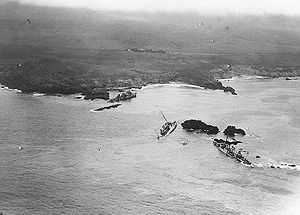USS Fuller (DD-297)
 | |
| Career | |
|---|---|
| Namesake: | Edward Fuller |
| Builder: | Bethlehem Shipbuilding Corporation, Union Iron Works, San Francisco |
| Laid down: | 4 July 1918 |
| Launched: | 5 December 1918 |
| Commissioned: | 28 February 1920 |
| Decommissioned: | 26 October 1923 |
| Fate: | Wrecked in the Honda Point Disaster, 8 September 1923 |
| General characteristics | |
| Class and type: | Clemson-class destroyer |
| Displacement: | 1,190 tons |
| Length: | 314 ft 5 in (95.83 m) |
| Beam: | 31 ft 8 in (9.65 m) |
| Draft: | 9 ft 4 in (2.84 m) |
| Propulsion: | 26,500 shp (20 MW); geared turbines, twin propellers |
| Speed: | 35 knots (65 km/h) |
| Range: | 4,900 nmi at 15 kt (9,100 km at 28 km/h) |
| Complement: | 122 officers and enlisted |
| Armament: | 4 × 4" (102 mm) guns, 12 × 21" (53 cm) torpedo tubes, 6 depth charge projector, 2 depth charge tracks |
USS Fuller (DD-297) was a Clemson-class destroyer in the United States Navy following World War I. She was the first Navy ship named for Marine Captain Edward Fuller (1893–1918), who was killed in the Battle of Belleau Wood.
History
Fuller was launched 5 December 1918 by Bethlehem Shipbuilding Corporation, San Francisco, California; sponsored by Miss Gladys Sullivan; and commissioned on 28 February 1920, Lieutenant Commander R. E. Rogers in command.
After a brief cruise to the Hawaiian Islands, Fuller arrived at her home port, San Diego, California, on 28 April 1920, and at once took up the schedule of training which took the Pacific destroyers along the west coast from California to Oregon. In February and March 1923, she joined in Battle Fleet maneuvers in the Panama Canal Zone, and returned to experimental torpedo firing and antiaircraft firing practice off San Diego.
In July 1923, with her division, she sailed north for maneuvers and repairs at Puget Sound Naval Shipyard. While making their homeward-bound passage from San Francisco, California to San Diego on the night of 8 September, the division went on the rocks at Point Honda when mistakes were made in positional calculations, causing the Honda Point Disaster in the foggy darkness. Fuller was abandoned, with all of her crew reaching safety. The ship later broke in two and sank. She was decommissioned 26 October 1923.
References
- This article incorporates text from the public domain Dictionary of American Naval Fighting Ships. The entry can be found here.
External links
- Fred Willshaw. "USS Fuller (DD-297)". Destroyer Archive. NavSource Naval History. Retrieved 2009-10-29.